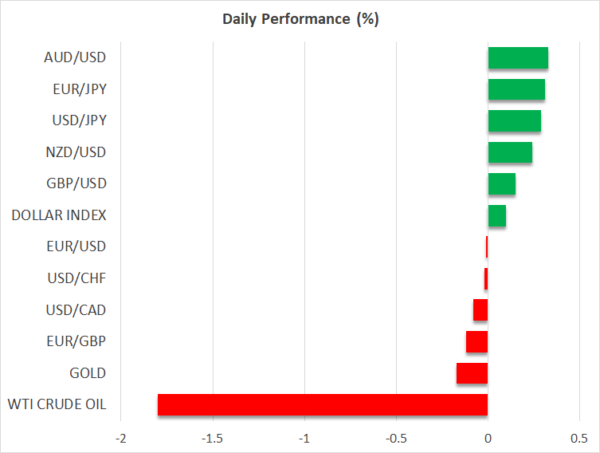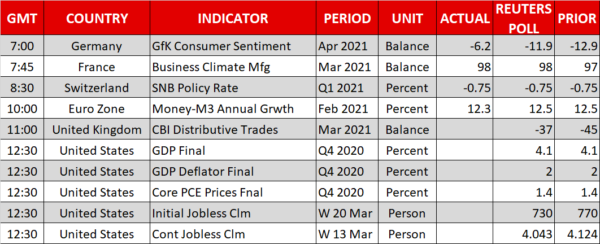- Dollar inches up to fresh highs but yen steps back as US stock futures steadier
- Euro and pound try to put a floor under losses after EU and UK pledge vaccine cooperation
- Oil prices see-saw on Suez Canal blockage, European lockdown woes
Dollar extends gains amid ongoing lockdown misery
The dented growth outlook in Europe continued to weigh on markets on Thursday as the latest announcements of virus curbs from the continent have dashed hopes of a speedy recovery in the euro area. While some negative spillover onto other regions is likely, the impact on the US economy will probably be very limited as the massive fiscal spending and turbo-charged vaccination campaign should more than compensate for any global headwinds.
The belief that there’s not a lot that can stand in the way of America’s recovery right now has emboldened the US dollar’s safe-haven status as well as attracted fresh flows into Treasuries. The greenback has been scaling four-month highs even as the benchmark 10-year Treasury yield has been on the retreat lately.
The dollar index is fast approaching 92.70 and the greenback has also been making inroads against the yen, jumping above the tough resistance barrier of 109, as the Japanese currency has been on a broad pullback today, signalling an improving risk tone.
Euro and pound still on the backfoot
A slight fading of the lockdown gloom is helping risk-sensitive currencies such as the aussie and kiwi post a modest rebound today. However, the euro and pound are still struggling, slipping to 4-month and 6-week lows, respectively, against the dollar.
The euro hasn’t been having a very good time in 2021 as endless lockdowns and a painfully slow rollout of Covid-19 vaccines in the EU have led investors to significantly scale back their growth expectations for the Eurozone. But after months of tight restrictions, a major reopening of the region’s economy is still not on the horizon as the highly contagious UK strain of the virus is causing havoc in many European countries, including France and Germany.
A shambolic management of the EU’s vaccine programme by the European Commission has only added to the recovery doubts. The EU has been trying to save face by blaming AstraZeneca for the supply shortages and threatening to ban the export of vaccines produced in the bloc. EU leaders will hold a virtual meeting today to decide whether an export restriction is needed.
Such a move would hurt the UK the most where the majority of the EU’s exports go to. The risk that Britain’s own enviable vaccine rollout could be critically curtailed by EU export controls have taken the wind out of the pound’s sails, while this ‘third wave’ currently sweeping across Europe could soon make its way to the UK, hampering the recovery there too.
However, there was some good news yesterday after the EU and UK agreed to work together to resolve vaccine supply issues and this has steadied the slide in the two currencies.
Wall Street set for mild rebound
Equity markets were also calmer on Thursday, with most major indices in Asia closing in the green, brushing off a 2% drop in the Nasdaq Composite on Wednesday. European shares opened slightly lower but lacked momentum to bounce into positive territory as US stock futures were only marginally higher.
Wall Street has been lacking direction all week, with Fed Chair Jerome Powell delivering no surprises during his two days of testimony in Congress. In the meantime, the prospect of higher corporate taxes in the United States and renewed tensions with China, not to mention the setback in Europe’s fight against Covid, have all put a dampener on risk appetite.
The US Securities and Exchange Commission yesterday implemented measures to delist any foreign company from American stock exchanges that doesn’t meet US auditing standards. The decision is expected to mainly impact Chinese tech companies and pulled China’s CSI 300 index to three-month lows today. But it comes amid the standoff between Washington and Beijing over human right abuses in Xinjiang, which has been weighing on investors’ minds.
Oil unable to sustain Suez Canal gains
The slightly more positive risk sentiment was also not enough to prevent oil prices dipping again. Both WTI and Brent crude futures slipped by between 1.6%-2.0% today after a near 6% jump on Wednesday. Oil prices shot higher after a huge container ship got stuck in the Suez Canal, blocking the key shipping route and causing a major traffic jam. The blockage could disrupt oil supply if oil tankers aren’t able to pass through the route soon.
However, persisting doubts about the demand outlook for oil following the extended lockdowns in Europe continued to be a drag, pushing prices back down.















